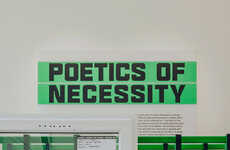
This Project Shows the Struggles Faced in Urban Italian Areas
Riley von Niessen — June 8, 2016 — Social Good
References: periferieinazione.it & designboom
As a part of the Venice Architecture Biennale 2016, ‘Campo Libero’ showed how Italian confiscated land can be better utilized.
The exhibit, inside the Italian pavilion at the event, was designed by 'Conceptual Devices' -- a company that seeks to create economic and social impact with its designs. The project was created with the help of 'Taking Care' and 'TAM associati' -- with teams who worked to create a mobile intervention design that would aid areas in the country that were affected by organized crime.
In the exhibit is information regarding the problem of confiscated land and the solutions that the team is taking to help those within these areas. This includes models and sketches of the mobile units, as well as program plans that will promote a better reality for the disadvantaged Italian suburbs.
Photo Credits: designboom, periferieinazione.it
The exhibit, inside the Italian pavilion at the event, was designed by 'Conceptual Devices' -- a company that seeks to create economic and social impact with its designs. The project was created with the help of 'Taking Care' and 'TAM associati' -- with teams who worked to create a mobile intervention design that would aid areas in the country that were affected by organized crime.
In the exhibit is information regarding the problem of confiscated land and the solutions that the team is taking to help those within these areas. This includes models and sketches of the mobile units, as well as program plans that will promote a better reality for the disadvantaged Italian suburbs.
Photo Credits: designboom, periferieinazione.it
Trend Themes
1. Confiscated Land Utilization - Designing mobile intervention programs for confiscated land can help neglected urban areas achieve better economic and social impact.
2. Socially Responsible Design - Adopting a locally focused design approach that addresses issues faced by affected communities can create positive social change.
3. Innovative Solutions for Urban Crime - Utilizing design thinking can help generate creative and efficient solutions for tackling problems related to organized crime in urban areas.
Industry Implications
1. Architecture - Architecture firms can take up the responsibility of designing pragmatic solutions that help address social issues faced by urban communities.
2. Social Enterprise - Social enterprises can take up the challenge of addressing issues of social justice and providing aid and resources to disadvantaged communities affected by urban crime.
3. Urban Planning - Urban planning experts can work together with other professionals to develop comprehensive solutions for tackling urban crime and improving the quality of life in affected areas.
2.2
Score
Popularity
Activity
Freshness























